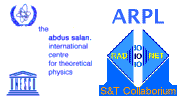
SCHOOL ON RADIO USE FOR
DIGITAL AND MULTIMEDIA COMMUNICATIONS
11th
February - 1st March
2002
, Trieste
(Italy)
-
|
|
|
|
|
|
|
|
 |
|
SCHOOL ON RADIO USE FOR DIGITAL AND MULTIMEDIA COMMUNICATIONS
|
|
|||
|
- |
|
|
|
|
|
|
From carlos_avenda_o@hotmail.com Date: Fri, 01 Mar 2002 00:20:38 From: carlos avendaño Subject: Diary of THURSDAY, 28 FEBRUARY 2002 SCHOOL ON RADIO USE FOR DIGITAL AND MULTIMEDIA COMMUNICATIONS 11th February - 1st March 2002 , Trieste (Italy) THURSDAY, 28 FEBRUARY 2002 School Diary Report: Thursday 28th February Today was the last day of school, and we are not going to meet each other any more. With this feeling we begun our day today. The weather was fine and the lectures begun as usual at 9.00. The first session was conducted by Dr. E. Pietrosemoli, who introduced us the 802.11: System Performances. In his lecture he focused on different things depending on application and user interests such as data-rate, throughput, response times, capacity and power consumption. He showed us how throughput depends on configuration, on protocol stacks, on the number of stations in cell, on file size and on the path between station and AP. He showed us also some measurements using WLAN at 2 Mbit/sec. In this lecture we also saw that the number of stations for "radio-cell" depends on bandwidth requirements per station, available bandwidth per cell, the dimensions of the cell and of the number of co-located cells, witch can be increased by using additional channels. Then he told us the dimensions of cells and power consumptions. At this time we took our lunch break as usual at 12.00. As we were supposed to go to the AQUARIUM of Trieste, we all met at the Galileo guest house at 2:00 in the afternoon, from there we all went to the bus station with Prof. Struzak, Prof. Pietrosemoli and Mr. Carlo Fonda. We stopped at Piazza Oberdan and walked all the way to the AQUARIUM, although it was raining we enjoyed our walk. Upon arrival to the AQUARIUM, we were very excited to see what was inside. Dr. Nicola Bressi from the AQUARIUM was waiting for us, and he arranged for a special visit to the museum. Dr. Bressi made a brief preview about the history of the AQUARIUM and its contents. He said that the museum was opened in 1933 in the building of Central Fish Market, it contains 25 tanks ranging in size from 200 to 2500 litres and one central tank containing 17000 litres of sea water. Collection includes: marine species of the Adriatic and a small section of Tropical fish and turtles.Three South African penguins also live in the Aquarium. It is now possible to visit a beautiful exibition of reptiles and amphibians and that was not available for many years. The AQUARIUM consists of two floors. We started with a nice view of Penguins and we liked them very much, there were only three of them and they share the same pool with many large-sized fishes. We were told that some type of fishes changes from one sex to another, as the need dictates. The guide showed us around the museum, and he also gave us some small fishes to feed the "Cernia" fish. In the second floor we saw snakes, the guide told us a sad story about how they found some of them and we took some photos with those snakes holding them in our hands and necks. The guide also mentioned that in order to feed the snakes, they kill mice because some of the snakes are not able to do it by themselves because these snakes are not in their natural environment. We saw frogs and the guide told us about their reproduction, we saw many funny things about them. We finished our visit to the museum with a very interesting view of the Colombian "Iguana" and went back feeding the fishes again. It was a very enjoyable and interesting day for us. Carlos Avendaño Universidad de Antioquia Medellin-Colombia <carlos_avenda_o@hotmail.com>
|
Page updated at 1st March 2002, © 2002 ICTP-ARPL, HTML by cfonda
|